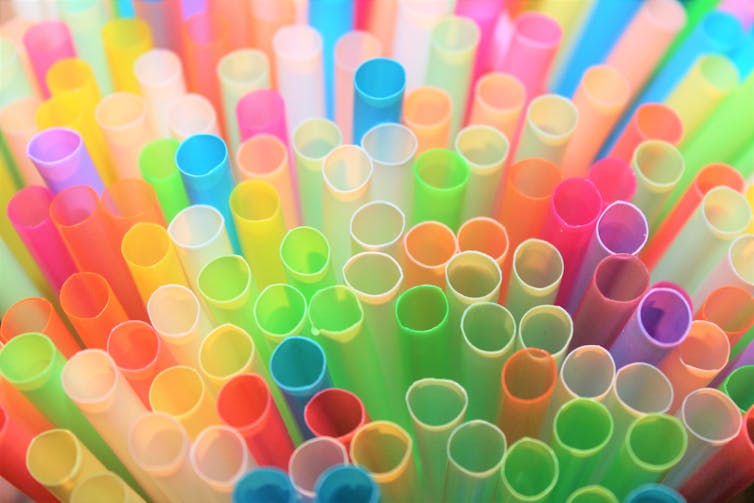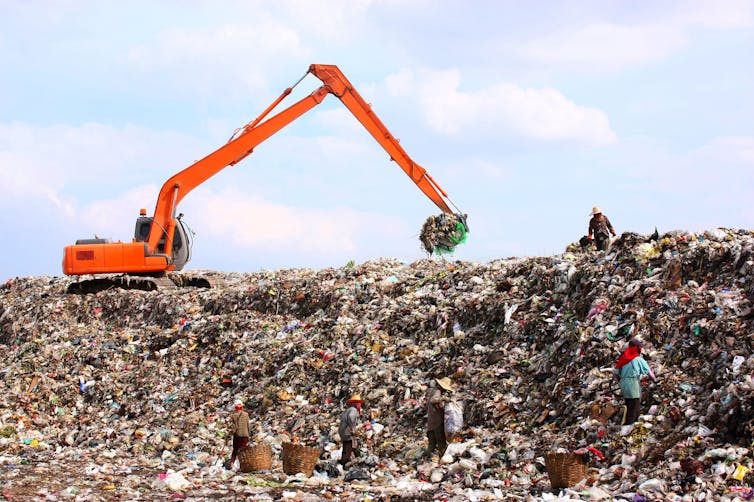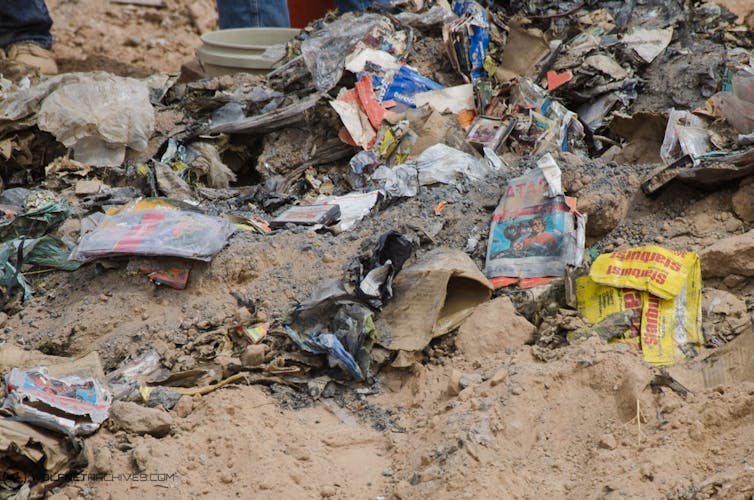Plastic is now part of our planet’s fabric – a scientist and archaeologist discuss what happens next

Mohamed Abdulraheem/Shutterstock
Dr Sharon George, Keele University and Matt Edgeworth, University of Leicester
This is an article from Head to Head, a series in which academics from different disciplines chew over current debates.
Sharon George: Plastics are ingrained in our everyday lives. Since 1950, it’s estimated that we have produced billions of tonnes of plastic, and most of this is not recycled.
Plastics have spread around the world through oceans, rivers and the air to every part of the planet. In rivers and oceans, plastic moves vast distances and is now found right through the water column of the oceans, from the surface to the deepest trenches.
We don’t yet know how long this material will prevail in these environments but it will certainly be longer than the lifespan of the person who used it. And it’s accumulating. This impact, like rising CO₂ levels, is man-made. No amount of recycling schemes and ocean clean-ups are going to totally remove the mark that we have left. Plastics are a scar that will hopefully warn future generations of the folly of unsustainable over-consumption.
Matt Edgeworth: As well as spreading through air, rivers and ocean currents, plastics are finding their way into soils, landfills and deep ocean sediments. As such, they are infiltrating into strata – layers of rock and mud in the ground – thus becoming part of the archaeological and geological records. They are not only to be found in surface environments, where they are highly visible, but are getting into subsurface layers too.
In some of these buried environments, plastic objects stand a good chance of being fossilised – a process whereby the hard material may decay or dissolve, but its exterior form survives as a mould which then gets filled with other minerals and becomes a cast of the original object. In this way, familiar forms of commonplace plastic items such as drinking straws may survive as traces in the ground not just for a few hundred, but for millions of years.

A brief history of plastics
Sharon: Polymers from natural materials were used by people as early as 1200BC, when the Olmec people used latex and vine extract to create rubber. In the 1840s, sulphur was used to vulcanise rubber, stabilising it and making tyre production possible.
A closely-related material, gutta-percha, is a natural latex. This early thermoplastic was used from the mid-1800s, enabling telegraph wires to be laid at the bottom of the sea and electrical wires to be insulated. Other natural polymers resembling modern plastic were developed from cellulose, a natural protein found in wood. The first, parkesine, was developed to produce celluloid in 1870, a medium for cinema film.
But it was during the 20th century that plastics really took off. In 1907, Leo Baekeland invented the first synthetic plastic, bakelite, from fossil fuel-based chemicals. These revolutionary plastics were easy to mould and could be quickly mass produced. These materials were popular, cheap and built to last. The pace of development increased and by 1935 other polymers, such as polystyrene, polyester, PVC, polythene and nylon were all being manufactured from fossil fuels.

Matt: That’s an excellent historical summary of plastics as a modern material. But as an archaeologist, I see the development of plastics as part of a much longer and broader set of technological trends, extending back over the last 20,000 years or so to the first appearance of “novel materials” in strata.
Novel materials are characterised by their geological novelty, being unprecedented in earlier deposits. Made by humans rather than by natural process, they are entirely new in the four-and-a-half-billion-year history of the Earth. Ceramics appeared first – then bricks and tiles, glass, metal alloys, concrete, paper and so on. Look in any rubbish dump today and you will find all these novel materials and more in the profusion of items thrown away.
Plastics may be a relatively new development, but they are part of this trend towards greater diversification of humanly manufactured materials, all of which eventually find their way into the ground.
The amount of plastic we bury
Sharon: Despite their relative novelty and permanence, we continue to produce and pour plastics into the environment. Today it is thought that around 80% of the 8.3 billion tonnes of plastic ever made is still somewhere out there.
Matt: A large proportion of plastic waste is being dumped in landfill, where it remains “out of sight, out of mind”. What we see in the oceans is only the more visible tip of a largely invisible iceberg.
Let me give an example. Close to my home in south Bedfordshire are a series of landfilled quarries, now low artificial hills. The old clay pits, some of them over a kilometre wide and up to 55m deep, made convenient receptacles for landfill waste from London and other nearby cities and towns from the 1980s on. Even when the pits were full to the brim, more landfill was mounded up to form hills.
If you stand on top of the highest of these newly created hills, where the former quarry was deepest, over 65m of compacted landfill lies directly beneath your feet. In landfills of similar age in the USA, the proportion of plastic was found to be 20-24% by volume when sorted, reducing to about 16% by volume when compacted in the ground. Assuming the same proportion of plastic at this location, that would be the equivalent of a layer of plastic 10m thick.

Meanwhile, landfill material by no means always stays where it has been deposited. For example, many thousands of landfills are situated in lowland situations and therefore at risk from marine incursion, especially in view of anticipated sea-level rise due to climate change. Coastal erosion, river flooding and tsunamis can decimate landfills, leaving the heavier material where it is but taking the lighter and more mobile material such as plastic away. A significant proportion of plastic currently in the oceans derives from inundated landfills.
Escaping into the environment
Sharon: Once plastic escapes from landfill it will continue to degrade into smaller fragments. It can be ingested by creatures like birds and fish and get into drinking water. Microplastics and nanoparticles are already showing up in our food chain and tapwater.
The risks to human health of ingestion of nanoplastics is not fully known. But with rising numbers, our exposure is bound to increase and people reliant on fishing from highly polluted regions will be more exposed.
The pollution is wreaking havoc on wildlife, with animals being entangled or ingesting the plastic. Around 90% of seabirds have ingested plastic. We are adding around 8m tonnes of waste every year to the ocean and unless this stream of waste is cut off, the problem is going to get much worse.
Matt: But with all the focus today on the harm caused by plastics in rivers and oceans, is there not a danger that putting plastic waste into landfill might be seen as a less controversial alternative? In conveniently burying it out of sight, often oblivious to the fact that it might get released back into the wider environment at a later date, are we just storing up problems for future generations? Should we not be focusing on the dangers of disposal of plastics in earth as well as in water?
Sharon: Yes, we should be focusing on the dangers of plastic disposal in earth as well as in water. I think there is a real danger that people could assume that locking it in landfill means it will stay put until it finally degrades.
How long plastic takes to decay
Matt: It is generally assumed that plastics will decay in just a few hundred years or less, but more scientific research needs to be undertaken on this crucial point. It seems likely that plastic in the ocean will break down relatively quickly into microparticles, to be ingested into the food chain or otherwise to sink into the sediment on the ocean floor.
But plastics buried in earth could prove to be much longer lasting. Archaeological studies show that some modern landfills are so tightly sealed and capped they protect material within from erosive forces, effectively mummifying them. Neither rain nor sunlight nor air can penetrate in, and decomposition processes typically slow down after 20 years or so. In such an artificially sheltered environment, materials like paper and plastic may survive for surprisingly long times.
Sharon: Deep sea environments at low temperature, low light preventing photo degradation and higher pressure are thought to have a preserving effect too. But landfill could be just preserving this waste as well? It’s amazing to think that future archaeological finds could be the everyday items and gadgets we are using today.
Matt: Well, a recent excavation of Atari computer game products buried 10m down in a New Mexico landfill in 1983 revealed that the plastic game cartridges with associated packaging and shrink-wrapping showed little sign of decomposition after 30 years in the ground! Those cartridges which were not crushed were still playable, and were sold on eBay for thousands of dollars.

Recycling doesn’t work
Sharon: Despite its durability, we are using plastic as if it is disposable. Efforts to recycle have been shown to be seriously flawed, with supply chains for waste not all that they seemed.
Earlier this year it was reported that the UK sends out around half of its recycling abroad with insufficient checks on what was actually happening to it. The system was found to be open to fraud, leading to concerns that instead of being recycled the waste was being dumped in landfill, rivers and oceans. Exporters of UK waste were sending out contaminated and worthless mixed waste and fraudulently claiming the recovery notes that they would then sell.
It is clear that recycling alone, in its present form, does not work. We have to either stop using plastics or find alternative routes to dispose of plastic waste in a more sustainable way. Consumers are much more aware of the impact of plastics in the environment and are receptive to change, but there are limited choices.
Matt: Yes. We need to explore possible alternatives, for example by re-using plastics in large-scale engineering projects such as road and building construction. There are promising projects currently underway looking at the feasibility of using processed plastic waste as a replacement aggregate in concrete manufacture.
Sharon: Using plastic waste to replace raw materials makes a lot of sense. Pyrolysis is a really good way to break down the plastic to produce raw materials.
We could also develop new ways to break it down faster into useful chemical components. One way would be to digest the plastics using enzymes. Fungi and bacteria have been found that have a taste for plastic and can break it down to be able to use the carbon from it. Scientists in Portsmouth tried to reproduce the enzyme that PET-eating bacteria uses, and accidentally produced an even more efficient enzyme.
Reprocessing the plastic like this would help cut the amount of waste building up as pollution. Long-term, even if we stop pouring this waste into our environment, we will still shed millions of fibres and microplastics through washing synthetic clothes and wearing down tyres.
The problem is that conventional plastics are just too cheap. A price increase would level the playing field to make the use of new plastics more expensive compared to recycled plastic. Because the price of plastic should include the true downstream disposal costs. If this was the case, then we could afford better waste sorting and more viable recycling facilities to prevent the exporting of waste.
Matt: We’re both agreed that the amount of plastic being produced and discarded without being recycled is doing irreparable harm to other creatures and habitats. So much plastic is choking river and ocean environments that many forms of life are threatened. So much plastic is entering geological cycles that it is creating a substantial stratigraphic signal of the Anthropocene in its own right. Even when the plastic itself has decomposed, the forms of some of the plastic objects that now litter the ocean floor may be preserved as trace fossils in sedimentary rock.
We might imagine picking up a stone in tens of millions of years’ time and finding – instead of the shells of former sea creatures – the shapes of cotton buds, coffee spoons, fishing nets, CD cases, water bottles, biros …
Sharon: and game cartridges.
This article is republished from The Conversation under a Creative Commons license. Read the original article.
Most read
Contact us
Andy Cain,
Media Relations Manager
+44 1782 733857
Abby Swift,
Senior Communications Officer
+44 1782 734925
Adam Blakeman,
Press Officer
+44 7775 033274
Ashleigh Williams,
Senior Internal Communications Officer
Strategic Communications and Brand news@keele.ac.uk.


